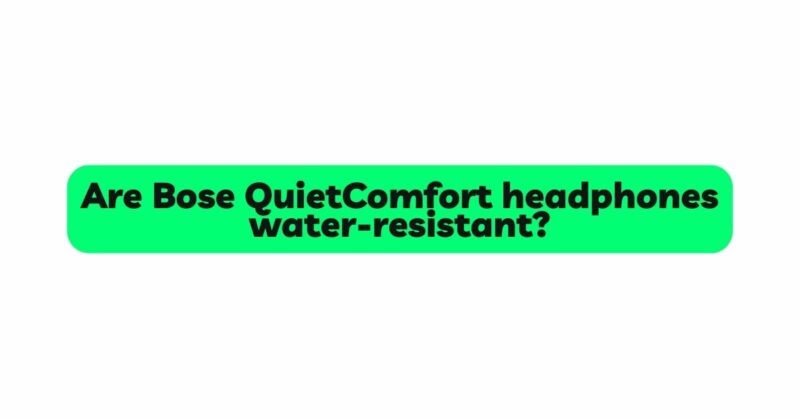Bose QuietComfort headphones have garnered a loyal following for their superior noise-canceling capabilities and outstanding sound quality. As users seek to integrate these high-performing headphones into various aspects of their lives, one question often arises: are Bose QuietComfort headphones water-resistant? In this comprehensive article, we will explore the water-resistance features of Bose QuietComfort headphones, understanding their durability and protective measures to ensure these premium audio devices remain in optimal condition.
Understanding Water-Resistance in Headphones:
Water resistance refers to a device’s ability to withstand exposure to water and moisture without sustaining damage. The Ingress Protection (IP) rating system provides standardized information about a device’s protection against solids and liquids, including water. IPX ratings specifically indicate the level of water resistance for electronic devices, with higher digits denoting greater protection.
IPX ratings for water resistance range from IPX0 (no protection) to IPX8 (full protection against submersion beyond 1 meter for an extended period). These ratings assist users in determining the suitability of their devices for various environments and activities, particularly those involving water exposure.
Bose QuietComfort Headphones Water Resistance:
As of the time of writing this article, the water-resistance capabilities of Bose QuietComfort headphones vary depending on the specific model. Bose offers a range of QuietComfort headphones, each catering to different needs and preferences. To provide an accurate assessment of water resistance, we will examine the water-resistance features of various Bose QuietComfort headphone models.
- Bose QuietComfort 35 II (QC35 II):
The Bose QuietComfort 35 II headphones are a popular choice among users seeking a balance between comfort, noise cancellation, and audio quality. The QC35 II headphones do not come with an official IPX rating, indicating that Bose does not market them as water-resistant.
However, the materials and design of the QC35 II headphones may offer some degree of protection against occasional splashes and light rain. While they are not designed for exposure to water or submersion, they can handle minor moisture contact during regular use.
- Bose QuietComfort Earbuds:
The Bose QuietComfort Earbuds are an in-ear, true wireless version of the QuietComfort series, offering exceptional noise cancellation and sound performance. These earbuds come with an official IPX4 rating for water resistance.
An IPX4 rating signifies that the QuietComfort Earbuds are resistant to splashes from any direction. This makes them suitable for sports, workouts, and light outdoor activities, offering peace of mind during activities that may involve sweating or light rain.
- Bose QuietComfort 45 (QC45):
At the time of writing, the Bose QuietComfort 45 headphones had not been released yet. Therefore, their water-resistance capabilities were not officially confirmed. Bose may choose to provide an IPX rating for this model or design it with specific water-resistance features, but this information remains speculative until official confirmation is available.
Practical Tips for Protecting Bose QuietComfort Headphones from Water Damage:
Regardless of the water-resistance capabilities of your Bose QuietComfort headphones, taking preventive measures can help safeguard them from water-related damage. Here are some practical tips to protect your headphones:
- Avoid Submerging in Water: Regardless of the headphone model, avoid submerging them in water. Submersion can cause irreparable damage to the internal components and void the warranty.
- Be Cautious in Rainy Weather: If your headphones do not have an official IPX rating, exercise caution during rainy weather. Seek shelter and protect the headphones by placing them inside your bag or under your clothing until the rain subsides.
- Use Water-Resistant Covers or Cases: For Bose QuietComfort Earbuds and other water-resistant models, consider using water-resistant covers or cases during outdoor activities. This additional layer of protection can further shield the headphones from moisture exposure.
- Proper Maintenance and Cleaning: Regularly clean your headphones to remove sweat residue and dirt. Use a slightly damp cloth or a mild cleaning solution specifically designed for electronics. Ensure that the headphones are powered off and disconnected from any devices before cleaning.
- Store Properly After Use: When not in use, store your headphones in a dry and well-ventilated area. Avoid leaving them in confined spaces such as gym bags or pockets where sweat or moisture can accumulate.
- Wipe Off Moisture: If your headphones come into contact with light moisture or a few raindrops, promptly wipe them off with a dry cloth. Avoid using a wet cloth, as it might push moisture into the headphone’s delicate components.
- Check the Manufacturer’s Warranty: Review the manufacturer’s warranty to understand what it covers in terms of water damage. Keep in mind that water-related incidents may not be covered, so taking precautionary steps is essential.
Conclusion:
The water-resistance capabilities of Bose QuietComfort headphones vary based on the specific model. While some models like the Bose QuietComfort Earbuds come with an official IPX4 rating, indicating water resistance against splashes, others, like the Bose QuietComfort 35 II, do not have an official IPX rating.
Regardless of the water-resistance features, it is essential to exercise caution and implement protective measures to prevent water-related damage. Avoid submerging your headphones in water, be cautious during rainy weather, and consider using water-resistant covers or cases for additional protection.
Proper maintenance, regular cleaning, and appropriate storage practices will contribute to the longevity of your Bose QuietComfort headphones. Whether you own a water-resistant model or not, understanding the water-resistance limitations and taking preventive measures will help ensure that you can continue enjoying exceptional audio performance in various environments without compromising the integrity of your headphones.


